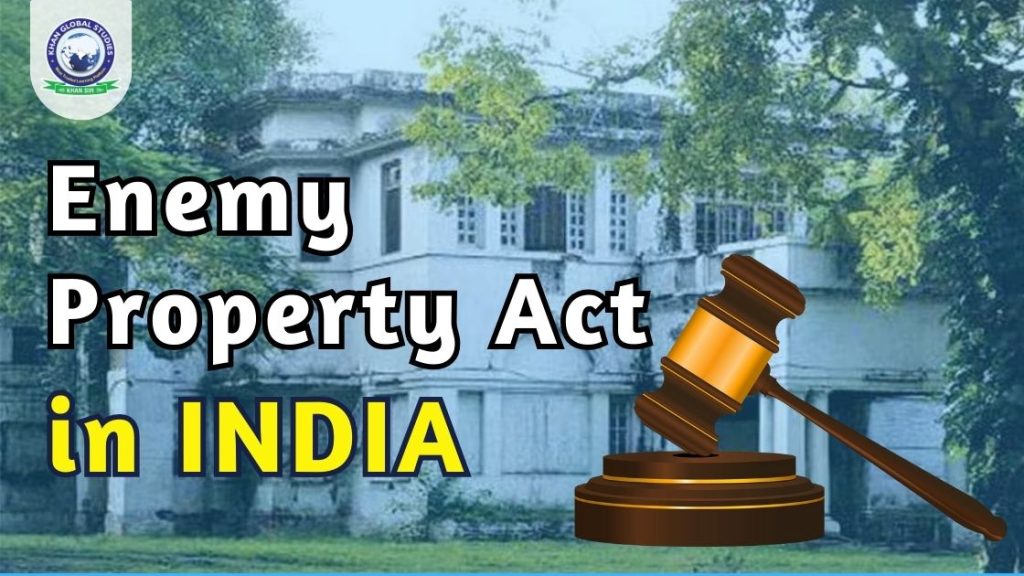Enemy Property Act, 1968; It was passed after the 1965 war with Pakistan. According to this Act, all the immovable properties of people who migrated to Pakistan after the partition of 1947 or the wars with Pakistan in 1965 and 1971 and acquired citizenship there were declared ‘enemy property’ and confiscated by the Government of India. It has been done. Enemy Property Act, 1968; Gives the right to take care of the enemy’s property to the legal heir or legal representative of the property.
After almost 200 years of British rule, India gained independence on 15 August 1947, but with this independence, a part of the country got separated from the Indian land which was named Pakistan. In this partition, lakhs of people went from India to Pakistan and from Pakistan came to India. Those who left the country also left behind valuables like their land, houses, shares in companies and bank balances.
Apart from the partition of 1947, after the India-China war of 1962 and the India-Pakistan war of 1965 and 1971, many people migrated to China and Pakistan and took citizenship there. Many Indian people have left the country leaving China and Pakistan. China and Pakistan had confiscated the property of the people of India. For this reason, the Indian government also took a similar step.
What is the Old Enemy Property Act, 1968?
The Enemy Property Act, 1968 is an act passed by the Indian Parliament according to which the Government of India will have authority over enemy property. Enemy Property Act, 1968; It was passed after the 1965 war with Pakistan. According to this Act, all the immovable properties of those who migrated to Pakistan after the partition of 1947 or the wars of 1965 and 1971 and took up citizenship there were declared ‘enemy property’. After this, for the first time, based on property, those Indian citizens whose ancestors were citizens of an ‘enemy’ nation were placed in the ‘enemy’ category.
Enemy Property Act, 1968; Gives the right to take care of the enemy’s property and transfer it to the legal heir or legal representative of the property.
What does the new Enemy Property Act, 2017 say?
The President of India passed an ordinance to amend the Enemy Property Act, 1968 on 7 January 2016, but Union Minister of State for Home Affairs Kiren Rijiju introduced the Enemy Property (Amendment and Validation) Bill in Parliament and the bill was passed by the Rajya Sabha. 10 March. It was passed on 2017 while the Lok Sabha passed it on 14 March 2017.
According to the new law, the definition of enemy property has changed, now those people are also enemies who may be citizens of India but who have inherited property which is in the name of a Pakistani citizen.
With this amendment, the government has also got the right to sell such property, that is, now the ownership of enemy property has gone to the Government of India. Due to this change, now all the property of Raja Mahmudabad belonged to the Government of India.
The following main changes have been made in the new law;
- The guardian is deemed to be the owner of such property and this is effective from 1968.
- Now citizens of India will not be able to inherit enemy property.
- All the properties sold so far have been declared illegal.
- In most cases, civil courts will not have jurisdiction to hear cases related to enemy property.
- Enemy property cases will be heard only in the High Court and the Supreme Court.
- The sale of enemy property will be done only under the supervision of the Ministry of Home Affairs or the Custodian of Enemy Property of India (CEPI).
- Now enemy property cannot be transferred to anyone else and this rule will also apply to property transferred before and after 1968.
- The sale proceeds will be deposited as disinvestment proceeds in a government account maintained by the Finance Ministry.
How many enemy properties are there in India?
It is important to mention here that there are a total of 9,280 enemy properties in India, so far 6,289 enemy properties have been surveyed and the remaining 2,991 properties are under survey. The Home Minister ordered that such properties where no one is living should be vacated so that they can be auctioned soon. Most of the enemy properties in India belong to people going to Pakistan.
Uttar Pradesh has the highest number of properties in the country at 4,991. Apart from this, there are 2,735 such properties in West Bengal and 487 such properties in the capital Delhi. Of these, 126 properties belong to people taking Chinese citizenship. A maximum of 57 enemy properties of Chinese citizens are in Meghalaya, while 29 are in West Bengal and 7 such properties are in Assam.
Currently, CEPI holds over 6.5 crore shares of 20,323 shareholders in 996 companies. Out of these 996 companies, 588 companies are still operating. The process of selling these shares should be approved by the alternative mechanism, which will be chaired by the Finance Minister, although the Home Minister and the Minister of Road Transport and Highways will also be involved.
What are the benefits of the Enemy Property Act to the Government of India?
The changes in the Enemy Property Act, 1968 will give the Government of India about Rs 3000 crore from properties lying idle for decades, which can be used for the country’s infrastructure development and social welfare programmes. Apart from this, a message will also be sent to the forces involved in anti-India activities that their efforts against India will ruin them socially and economically.
Why has the Enemy Property Act, 1968 been changed?
Raja Amir Ahmed Khan of the princely state of Mahmudabad moved to Pakistan after the partition of India and Pakistan in 1957, but his wife and son (Muhammad Amir Muhammad Khan or Raja Mahmudabad) remained in India and did not give up their Indian citizenship.
In 1965, when tensions between India and Pakistan began to increase, the Enemy Property (Surveillance and Registration) Order 1968 was issued. In the year 1973, the father of the present Raja Mahmudabad died in London.
After the death of his father, the present King Mahmudabad got the rights of his entire property in India but the government had declared his property as enemy property. However, Mahmudabad claimed that he was an Indian citizen and therefore had legal rights over his ancestral property.
The case went up to the Supreme Court and the SC ruled in his favour, then after a Supreme Court order in 2005, many of his properties were handed over to him.
However, the Government of India realized that if enemy property continued to slip out of the hands of the Government of India. In this manner, it would cause huge financial loss to the Government, hence the Government made changes in the Enemy Property Act, 1968.
Property of King Mahmudabad
Raja of Mahmudabad owns around 936 properties in Uttar Pradesh and Uttarakhand. His major properties in Uttar Pradesh include; include Malka Zamania in Golaganj, Butler Palace in Lucknow, Mahmudabad Mansion in Hazratganj, Halwasiya Court, and Lari Building. Apart from this, his assets include SP residence in Sitapur, DM residence, CMO residence and Lakhimpur Kheri SP bungalow.
Hopefully, based on the above article, you would have understood what is called enemy property, why the government has made a law to change the ownership of this property and what benefit the Government of India will get from it.



